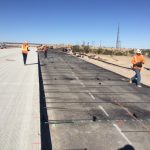2.1 Design Aspects:
The volume changes stresses in CRCP will be taken care by providing sufficient reinforcement to keep the cracks tightly closed while maintaining adequate pavement thickness to counteract the stresses produced by wheel loads. CRCP allows the concrete to develop very fine transverse cracks that seem to be uncontrolled and random. The spacings of transverse cracks that occur in CRCP is an important variable that directly affect the behavior of the pavement. Relatively large distances between cracks result in high steel stresses at the crack and in excessive crack widths. A decrease in crack spacing reduces the steel stresses and crack widths.
2.1.1 Crack Spacing:
The limits on crack spacing are based on the possibility of spalling and punch outs. Based on experience, the maximum spacing between consecutive cracks should be limited to 2.4m to minimize spalling. To minimize the potential of punch outs, the minimum desirable crack spacing is about 1.1m.
2.1.2 Crack Width:
The limit on crack width is based on a consideration of spalling and water infiltration. The crack width should be reduced as much as possible through the selection of higher steel percentage or smaller diameter reinforcing bars. As per AASHTO stipulation the allowable crack width should not exceed 1.0mm.
2.2 Steel Stress:
The limiting stress of 75% of the ultimate tensile strength is recommended. AASHTO Design Nomographs and Equation are available for determining the percentage of longitudinal reinforcement to satisfy the criteria of crack spacing, crack width and steel stress respectively. The optimum amount of steel reinforcement is selected in CRCP so that crack spacing lies between 1.1m to 2.4m, the crack width is less than 1.0mm and steel stress does not exceed 75% of the ultimate tensile strength. CRCP allows the use of slightly smaller load transfer co-efficient compared to JPCP. And hence the thickness requirement is less compared to JPCP. The maximum desirable crack spacing is derived from a correlation between crack spacing and incidence of spalling. Maximum crack spacing is derived from consideration of effect of slab length on the formation of punch-out.
Steel Reinforcement:
The amount and depth of longitudinal reinforcing steel are the most important aspects of steel reinforcement in CRCP as it affects transverse crack spacing and the width of the cracks. The longitudinal reinforcement in CRCP is used to control the fine transverse cracks that form due to volume changes in the concrete. The function of steel is to hold the random cracks tightly closed, to provide structural continuity and to minimize the penetration of potentially damaging surface water and incompressible.
Longitudinal Reinforcing Bars:
These are the main reinforcement in CRCP. The total area of longitudinal reinforcing bars required usually is stated as a percentage of the cross-sectional area of the pavement. The amount of longitudinal reinforcing bars is generally between 0.5% and 0.7% and it may be more where weather conditions are severe and also the temperature differentials are more. Transverse reinforcements are useful to support the longitudinal steel when the steel is preset prior to concrete placement. Transverse reinforcement may be lesser grade.
Transverse Reinforcing Bars:
The function of the bars is as follows:
1. To support the longitudinal bars and hold them at the specified spacing. When used for this purpose, the longitudinal bars are tied or clipped to the transverse steel at specified locations.
2. To hold unplanned longitudinal cracks that may occur tightly closed.
2.3 Typical Design of CRCP:
The following parameters are considered for design:
1. Design Life -> (a) 20 years for Flexible pavement
(b) 30 years for Rigid pavements.
2. Traffic Density ->(a) 5000 Vehicles/day on 4-lane road
For Rigid Pavements:
1. Concrete grade: M40
2. Grade of steel: Fe 415
3. Maximum temperature differential between top and bottom of Slab = 21°C (The maximum value for India as per IRC 58)
4. Difference between mean temperatures of the slab at the time of construction and coldest period = 30°C (Assuming 35°C at the time of construction and 5°C at coldest period)
Table No. 2.1: Comparison of Different Types of Pavements for Highways
| Item | Flexible Pavement | JPCP | CRCP | |
| Design Code | IRC-37 | IRC-58 | British-HD 26/94,Part-3,vol.7,section 2 | AASHTO’93 |
| Total pavement thickness (mm) | 800 | 675 | 625 | 610 |
| Grade of concrete | – | M40 | M40 | M40 |
| Spacing of contraction joints | – | 4.25 m | – | – |
| Steel reinforcement | – | Only at joints occasionally thin mesh in top surface | 0.69% long – 16mm @ 140mm c/c Trans – 12 mm@ 600 mm c/c | 0.57% long – 16 mm @ 140mm c/c Trans – 12 mm @ 600mm c/c |
| Durability | Poor (5-6 years) | Long (>30 years) | Long (>30 years) | |
| Saving in Fuel | – | 10-20% | 10-20% | |
| Maintenance | High | Less | Very less | |
| World experience | Poor performance | Good reports | Very good reports. 4500 km in USA; all states have started using CRCP | |
| Construction | Easy | Special care is needed | More special care needed | |
| Expertise in the country | Very large | Yes | Yes | |
| Corrosion problem | No | R/F at joints needs protection | No corrosion problem. |
3. METHODOLOGY
CRCP is characterized by the presence of a continuous steel reinforcement set into the cement and by the omission of transverse joints other than construction and terminal joints Instead of being concentrated in the contraction joints as is the case with JPCP, volumetric changes (due to temperature and moisture) result in the development of a large number of evenly distributed hairline cracks appearing at random. The amount of longitudinal reinforcement is determined so as to control cracking and to ensure structural continuity of the pavement. The aim sought is a great number of cracks fine enough to limit the penetration of de-icing salts and to ensure proper aggregate interlock which leads to a higher load transfer efficiency. One of the main arguments for the use of this type of slab is that it requires little or no maintenance. This represents savings in maintenance costs but also direct savings for users. Initial costs are heftier due to the reinforcement but these costs are similar to those for a conventional pavement after 10 to 15 years according to the World Road Association (PIARC), or after 15 to 18 years according to Belgian experts. Other favorable factors are a better long-term performance and longevity of pavement smoothness. The use of CRCP is recommended for urban and rural-area highways, especially where there is high-volume traffic and great number of trucks. Use of CRCP is widespread in the world, especially in the United States and Europe.
• The United States first used this concrete pavement in 1921. Several road tests were conducted during the 1940s and 1950s. Today, over 50 000 kilometers of highway lanes have been built in CRCP.
• Belgium built its first CRCP section in 1950. This country has made extensive use of this type of concrete pavement since 1970. Several projects were conducted since then to arrive at the current design. It is interesting to note that this country uses CRCP not only on its highways but also on its country roads and national highways. The participants of the 2001 Québec Tour in Belgium had the opportunity to witness first-hand this country’s know how in the area of concrete pavement.
• France has used CRCP since 1983 and, to date, it has over 600 lane-kilometers, as well as, several rehabilitation projects underway.


